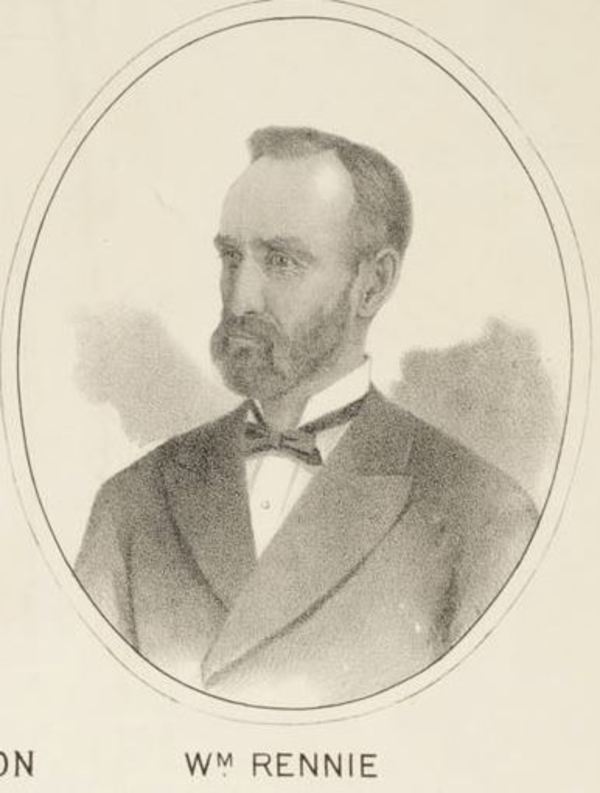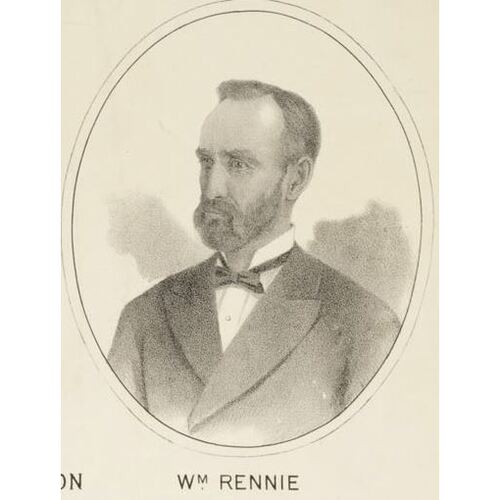
Source: Link
RENNIE, WILLIAM, agriculturist, seed merchant, farm superintendent, and author; b. 15 March 1835 in Scarborough Township, Upper Canada, son of Robert Rennie and Elizabeth Fife; m. 13 March 1862 Sarah Glendinning of Scarborough, and they had four sons; d. 24 July 1910 in Swansea (Toronto).
William Rennie was born in a log cabin and learned the rudiments of agriculture on the Scarborough farm of his parents, who had emigrated from Kirknewton, Edinburghshire, Scotland, in 1832. He left the homestead in 1860 to take up farming in Markham Township on 120 acres belonging to his father and, from 1867, to Rennie himself. By 1864 he was importing wheat-, barley-, and oat-seed from Scotland to improve his crops and to test his theory that a “change of seed grain” could allay the crop failures plaguing many farmers in Upper Canada.
This experience may have led to his decision, in 1870, to rent out his farm, move his family to Toronto, and found the William Rennie Company Limited, a purveyor of agricultural and horticultural seeds and supplies for the next 91 years. The business, centred at Adelaide and Jarvis streets, eventually had offices in Montreal, Winnipeg, and Vancouver, and, at Rennie’s death, was described by the Toronto Daily Star as the “largest of its kind in Canada.” Beginning in 1871, it also reached out to farmers and gardeners across Canada through increasingly colourful, annual mail-order catalogues.
When Rennie entered business, Toronto had fewer than a dozen seed houses, the most prominent being those of James Fleming, George Keith, George Leslie, and Joseph Adolph Simmers. In 1873 John S. and Richard Clarke Steele, with Sylvester E. Briggs, founded Steele Brothers and Company, which, as Steele-Briggs Seed Company, would buy the Rennie firm in 1961. The success of such enterprises lay in their dedication to supplying seed that was reliable under Canadian conditions such as low temperatures and short growing seasons. Although farmers and gardeners could continue to order seed from the United States and Europe and to purchase it locally from general merchants, they could place greater confidence in the seed offered by the better Canadian houses. Even before the establishment of federal experimental farms, the Rennie company was conducting its own trials, selecting and developing promising strains and varieties of grains, vegetables, and flowers, and introducing them through its catalogues.
As a site for a seed farm and trial grounds, Rennie took control about 1880 of his Markham property. By placing a foreman in charge, this “city man” was able to return it to such “a very high style of farming” that in 1883 he won the first silver medal for farms given by the Council of the Agriculture and Arts Association of Ontario. In the same year’s competition, which was limited to the central district of the province, his brother Simpson won the gold medal for his management of the Scarborough homestead.
Complementing William Rennie’s interests in seed-marketing and farming were his abilities as an entrepreneur. He was manufacturing a grass-seed sower as early as 1873; during the 1880s he was associated with the manufacture and sale of draining-machinery. His 1888 seed catalogue noted that he also imported from Scotland and bred Clydesdale horses and Shetland ponies.
In private life Rennie was said to have been a generous and public-spirited individual, a faithful Presbyterian, an avid curler, an active member of the Liberal party, and a man proud of his pioneer heritage. He helped organize Toronto’s first industrial exhibition in 1879, and served as a vice-president and later as an honorary director. In 1883 he was on the management committee of Toronto’s first annual fat-stock show, the forerunner of the Royal Agricultural Winter Fair. He joined the York Pioneers in 1879 and took part that year in their move of an early log cabin, that of Henry Scadding’s father, to the new exhibition grounds – an event he could still describe in detail during his presidency of the society in 1903–9.
When Rennie withdrew from his seed company in 1889, he was succeeded in the business by three of his four sons, Robert, John, and Thomas (the fourth, William, would become an independent missionary and would gain great respect in Hakodate, Japan). In preparation for retirement, he had the previous year sold his Markham farm and purchased a five-acre property west of Toronto. There, in 1889, he built a brick home, to which he and his wife moved. Located on the west bank of Grenadier Pond and ascending from it in a series of landscaped terraces, the property became a familiar sight from High Park, on the opposite shore.
Rennie immediately took a leading role in the development of this district, which in 1926 would be incorporated as the village of Swansea. In 1889, in one of 12 row-houses he had built on Kennedy Avenue, he brought together a group of Presbyterians for services and a Sunday school, before the erection of Morningside Church in 1891. In the same house, he provided space in 1890 for day classes, which preceded the construction of Swansea Public School. In 1892–93, near their parents’ home, the sons established for the Rennie company new trial grounds and a greenhouse.
One of the most strenuous periods of Rennie’s life began four years after his retirement from business. In October 1893, at the invitation of Ontario’s minister of agriculture, John Dryden, he took up the new position of farm superintendent at the Ontario Agricultural College and Experimental Farm in Guelph [see William Johnston*]. His duties included not only improving the farm and supervising farm-hands and students, he reported in 1897, but also frequenting “farmers’ institute meetings, lecturing in college, attending to visitors nearly every day during the month of June, drawing plans for beautifying country homes, besides attending to a large correspondence.” When he resigned in 1899, at the age of 64, he received high praise from college president James Mills* for having “revolutionized” the farm and devoted himself “late and early, with untiring energy.”
Although Rennie was not primarily a writer, his published contributions to agriculture in Ontario were noteworthy. They began with a letter on seed grain to the editor of the Canada Farmer in 1864; included, while he was at Guelph, at least a dozen articles for the Ontario Agricultural College Review, Farming, and Farmer’s Advocate and Home Magazine; and ended with an article in Farm and Dairy in 1909. As well, he authored two books: Successful farming; how to farm for profit . . . (Toronto, 1900) and Rennie’s agriculture in Canada . . . (published posthumously in Toronto in 1916). Through his writing, he promoted the values of farm life and beautification, and stressed the use of improved methods of scientific farming: thorough draining, covered drains, shallow ploughing, short rotation of crops, more efficient fencing and ensilage, and careful cost-accounting.
From Guelph, this “deep original student of the soil” returned to Swansea, where he died in 1910, two months after a paralysing stroke. In 1934 John Rennie continued his father’s public spiritedness by donating land to Swansea for a playground and park. The site of the Rennie home and the company’s trial grounds were, however, eventually redeveloped.
[The author is indebted to the Reverend J. William Lamb of Toronto for making available his largely unpublished genealogical research on the Rennie family. p.c.]
A listing of 20 articles by William Rennie appears in Ontario rural society, 1867–1930: a thematic index of selected Ontario agricultural periodicals, comp. Edwinna von Baeyer (pamphlet enclosing microfiche, Ottawa, 1985; copy at AO), including two letters to the editor of the Canada Farmer (Toronto): “Change of seed grain,” 1 (1864): 52 (his earliest publication), and “The liability of seedsmen,” 12 (1875): 198.
AO, Abstract index to deeds, Markham Township, concession 2, lot 14, instruments 52755 (1854), 90301 (1867), 6204 (1888) (mfm.); F 775, MU 2140, 1968, no.3; RG 8, I-6-B, 85: 21. Royal Botanical Gardens, Centre for Canadian Hist. Horticultural Studies (Hamilton, Ont.), Coll. of Canadian nursery and seed catalogues, William Rennie Co. Ltd., catalogues, 1882–1920; William Rennie Sr file, Rennie family research notes by J. W. Lamb. York Pioneer and Hist. Soc. Arch. (Toronto), Docs. concerning William Rennie’s presidency of the society, 1903–9. Farmer’s Advocate and Home Magazine, 28 July 1910. Globe, 25 July 1910. Toronto Daily Star, 25 July 1910. Pleasance Crawford, “William Rennie Sr. (1835–1910): agriculturalist, seedsman, and York Pioneer,” York Pioneer (Toronto), 84 (1989): 28–32. Ontario Agricultural College and Experimental Farm, Annual report (Toronto), 1893–99. “Report of prize farm competition in group no.4,” Ont., Agriculture and Arts Assoc., Report of the council (Toronto), 1883: 33–49. J. R. Robinson, “A Canadian of the Canadians,” broadsheet obit. tribute in William Rennie Seed Co. Ltd., seed catalogue for 1911 (copies in the Centre for Canadian Hist. Horticultural Studies, and the Swansea Hist. Soc. Arch., Toronto). “Seed drills,” Canada Farmer, 10 (1873): 134–35.
Cite This Article
Pleasance Crawford, “RENNIE, WILLIAM,” in Dictionary of Canadian Biography, vol. 13, University of Toronto/Université Laval, 2003–, accessed January 1, 2026, https://www.biographi.ca/en/bio/rennie_william_13E.html.
The citation above shows the format for footnotes and endnotes according to the Chicago manual of style (16th edition). Information to be used in other citation formats:
| Permalink: | https://www.biographi.ca/en/bio/rennie_william_13E.html |
| Author of Article: | Pleasance Crawford |
| Title of Article: | RENNIE, WILLIAM |
| Publication Name: | Dictionary of Canadian Biography, vol. 13 |
| Publisher: | University of Toronto/Université Laval |
| Year of publication: | 1994 |
| Year of revision: | 1994 |
| Access Date: | January 1, 2026 |




